It's common knowledge that Mitsubishi Motors vehicles manufactured between 1989 and 1994 (and possibly some others) have problems with the Electrolytic Capacitors in their ECM / ECU (Engine Control Module / Engine Control Unit). Here I intend to document my findings with one such example of a common Mitsubishi vehicle that's affected rather heavily by this problem.
Last December, I bought a Mitsubishi Magna TR. These cars were the second generation of the Magna, produced from 1991 to 1996 as the TR & TS series at Mitsubishi's Tonsley Park Manufacturing Plant in Adelaide, South Australia. They were most commonly sold in Australia, but were exported across the world (including Europe, New Zealand, the Middle East and the United States) under various names and configurations, such as the Diamante, Sigma and V3000.
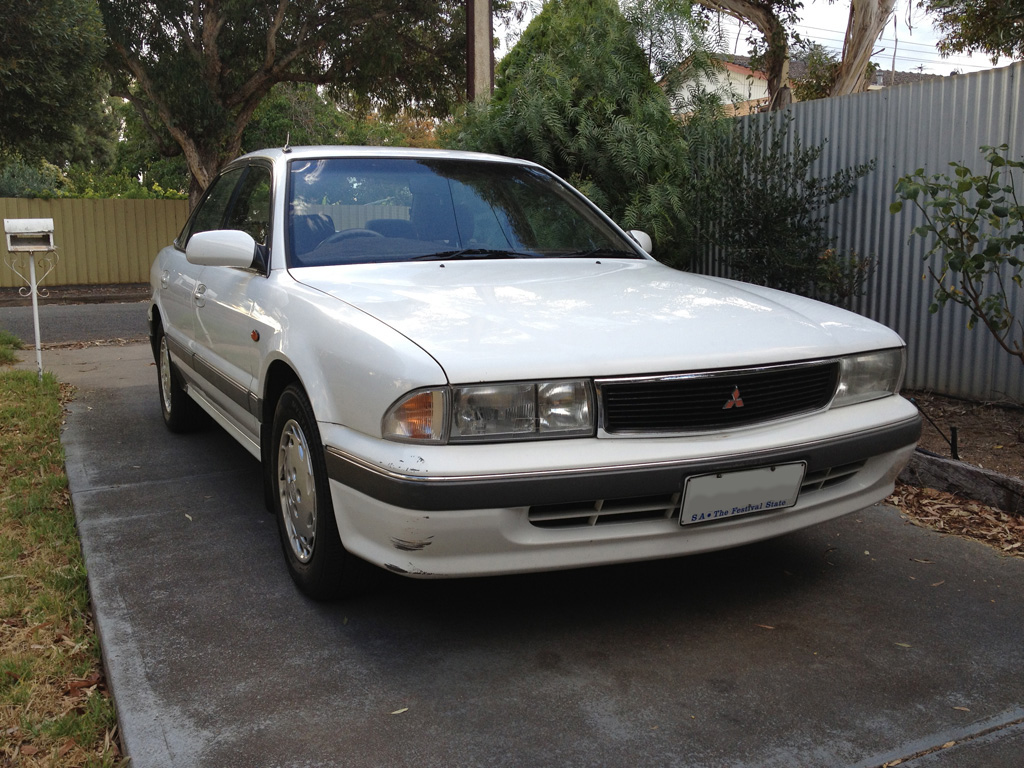
In case you were wondering what they look like - Here's one.
The Magna 2.6L was a common configuration in Australia, and the best way to describe it is essentially a Diamante with the V6 engine removed and a 2.6L 4-cylinder slotted in - the same engine found in the Mitsubishi Starion & Chrysler Conquest, the 4G54 "Astron".
All in all, they're rather well built cars. The mechanical components are rather robust, the interior trim is resistant to wear, squeaks and rattles and for the most part, electrical components and accessories tend to be trouble-free.
The Magna drivetrain is controlled by two separate control units, an ECU (Engine Control Unit) that controls the "ECI-Multi 2600" Multi-Point Fuel Injection system, and a TCU (Transaxle Control Unit) that controls the Mitsubishi F4A33 Automatic Transaxle.
While mechanically these cars are rather decent, failures in the control units or connected components - while simple to correct - are often misdiagnosed as catastrophic mechanical failures. As long as this continues, many of these cars will be written off as uneconomical to repair when in reality they may still have several roadworthy years left. Not brilliant for the uninformed owner, perhaps a little better for electronics hobbyists like us.
Leaking Electrolytic Capacitors in ECU
There are many different variants and revisions of the Mitsubishi 2.6L ECU, all manufactured for Mitsubishi Motors by Bosch. From what I can tell, the capacitors tend to be the same. I've examined two ECUs here, and they appear to mostly be the same, differing only by revision.
- Mitsubishi Part No. AW319647 (Bosch Part No. 9 260 060 023) Year 1992
- Mitsubishi Part No. AW335189 (Bosch Part No. 9 260 060 046) Year 1993
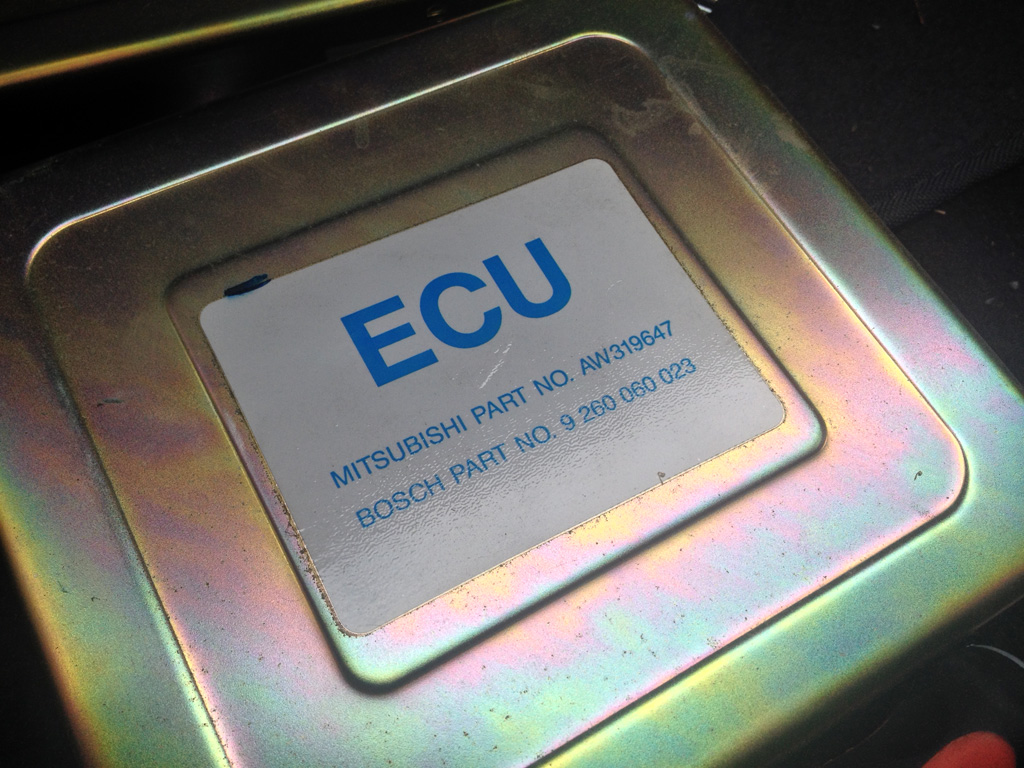
A Mitsubishi AW319647 ECU.
These ECUs contain three capacitors in total, two large Rubycons and a smaller capacitor.
- (2x) Rubycon 16v 100uF Electrolytic Capacitor, 105C
- (1x) 50v 22uF Electrolytic Capacitor, 85C
The problem is that the capacitors over time begin to leak from the base, slowly spreading electrolyte across the PCB and over surrounding components. In severe cases, you may be able to smell a "fishy" smell in the cabin, which is the leaking electrolyte. If left unattended, the electrolyte can short surrounding components or the capacitors themselves can fail, resulting in burned and failed components nearby or exploded electrolytic capacitors that often take surrounding components off the board with them. Ultimately the result is destruction of the ECU and a car that no longer starts.
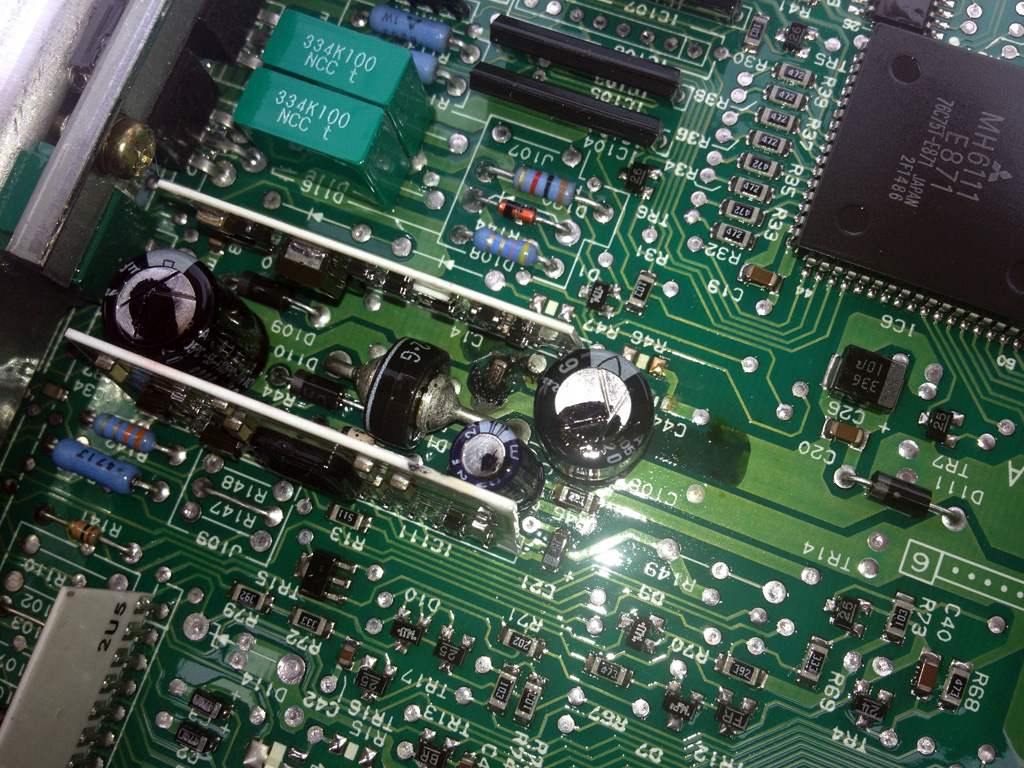
Leaking Capacitors and Spilled Electrolyte in a Mitsubishi AW319647 ECU.
Prior to total failure, the issue can manifest in a number of ways, such as a car that doesn't start consistently, a car that starts fine but idles poorly, a car that cuts out or stalls, or any number of other anomalies. In many cases, the car appears to run perfectly fine, and the only sign of failure is when the ECU releases its magic smoke. The only real sure fire way to know if your caps are leaking is to remove and inspect the ECU.
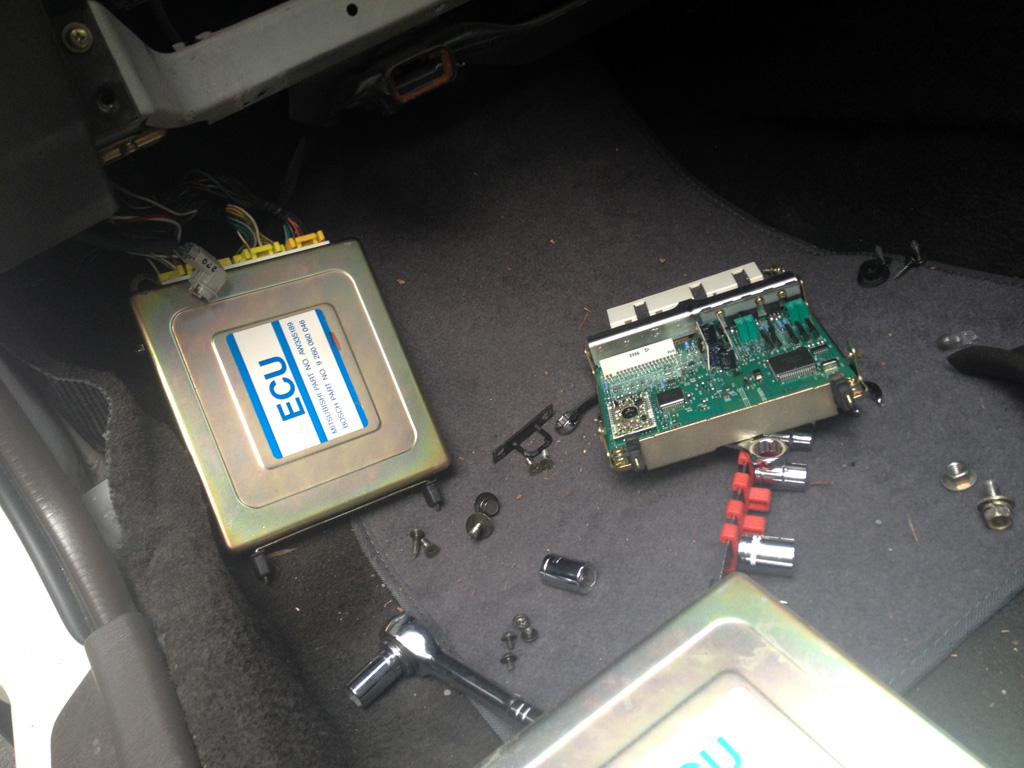
The ECU is located inside the dashboard on the left side of the vehicle. Pictured connected is a Mitsubishi AW335189 ECU.
Leaking Electrolytic Capacitors in TCU
There are several revisions and variants of the TCU (Transaxle Control Unit) in these cars as well. Some TCUs have two plugs, while others have three. The two are not compatible with each other. It is possible that these variations in the TCU have different capacitors as well, so once again, inspect your TCU first if you plan to do a capacitor job. I only have one TCU handy at the moment, a 2-Plug version.
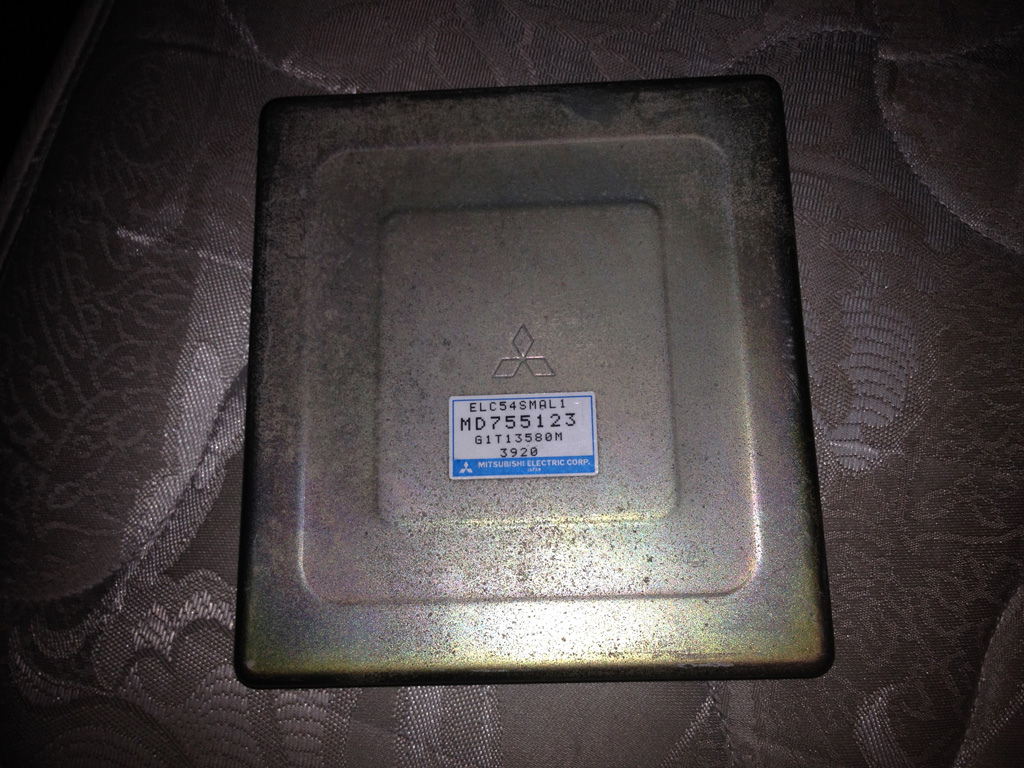
A 2-Plug Mitsubishi TCU. Markings: ELC54SMAL1 - MD755123 - G1T13580M - 3920 - Mitsubishi Electric Corp. Japan
The 2-Plug version appears to have the following capacitors:
- (1x) 50v 47uF Electrolytic Capacitor, 105C (Dark Blue in Colour)
- (2x) 25v 47uF Electrolytic Capacitor, 85C (Light Blue in Colour)
- (2x) 50v 1uF Electrolytic Capacitor, 85C (Yellow in Colour)
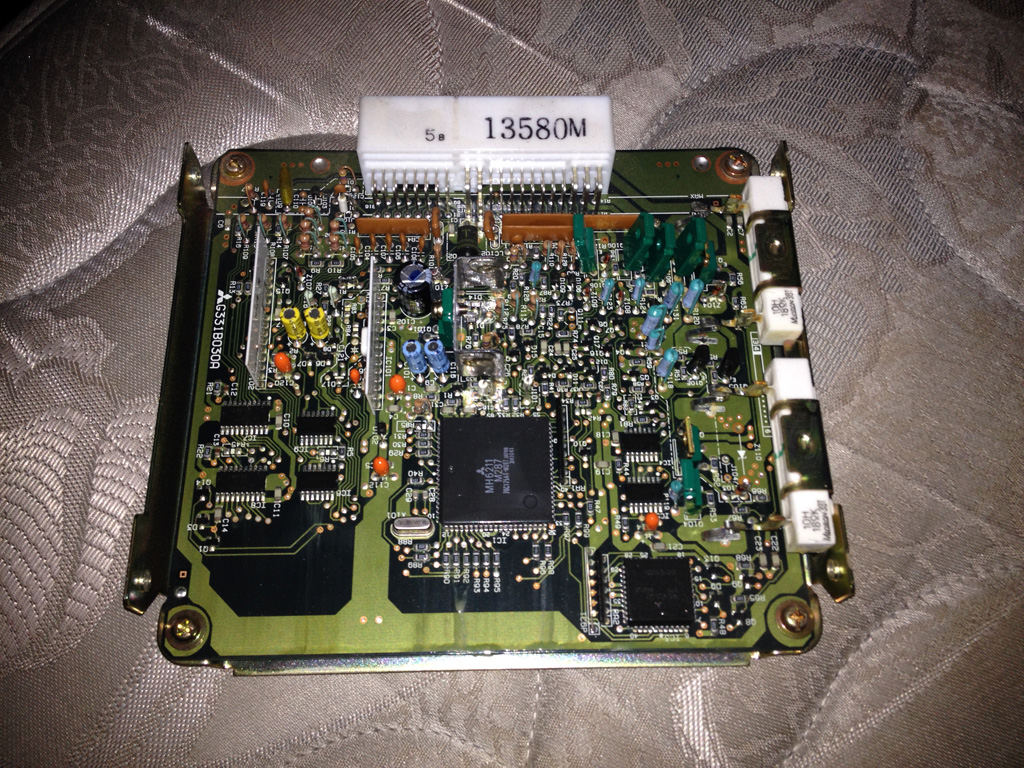
Inside the Mitsubishi MD755123 TCU. Capacitors pictured in upper left of circuit board.
The failure is largely the same as that of the ECU. Over time the capacitors begin to leak from the base, slowly spreading electrolyte across the PCB and over surrounding components and left unattended, this electrolyte can short surrounding components or the capacitors themselves can fail, resulting in burned and failed components nearby or exploded electrolytic capacitors. The car will still start, however it may be unable to select gears, or will only hold third gear (otherwise known as "Limp Home Mode" or "Limp Mode").
One common symptom of a failing TCU is that the car will still select gears, but will shift harshly on upshifts or downshifts, resulting in a violent "jerky" motion of the vehicle. This is often misdiagnosed by mechanics as a deteriorating gearbox, and the quotes are often costly - several thousands for the replacement of the automatic transaxle when the issue is a few dollars in capacitors at the most!
Sometimes the failure of these capacitors can toast the TCU to the point where replacement capacitors will show little to no improvement, so it's best to replace them before a catastrophic failure occurs. If the car is still shifting smoothly, it's still worth having it inspected. Better to catch it now and perform some preventative maintenance than to fork out for a refurbished TCU.
Changing the capacitors in the ECU and TCU together can save owners many headaches down the track and ensure that the car's electronics continue to operate smoothly. While I've used a Mitsubishi Magna in this example, it affects many Mitsubishi vehicles of the era, and it's not uncommon to hear of this issue on Galants, 3000GTs (GTOs) and anything else with EFI.
I'm not sure how it looks for other car makes, but if in doubt, it's worth checking over. After all, electrolytic capacitors do have a limited lifespan and the older the car, the more likely it is that they'll be failing.
Last December, I bought a Mitsubishi Magna TR. These cars were the second generation of the Magna, produced from 1991 to 1996 as the TR & TS series at Mitsubishi's Tonsley Park Manufacturing Plant in Adelaide, South Australia. They were most commonly sold in Australia, but were exported across the world (including Europe, New Zealand, the Middle East and the United States) under various names and configurations, such as the Diamante, Sigma and V3000.
In case you were wondering what they look like - Here's one.
The Magna 2.6L was a common configuration in Australia, and the best way to describe it is essentially a Diamante with the V6 engine removed and a 2.6L 4-cylinder slotted in - the same engine found in the Mitsubishi Starion & Chrysler Conquest, the 4G54 "Astron".
All in all, they're rather well built cars. The mechanical components are rather robust, the interior trim is resistant to wear, squeaks and rattles and for the most part, electrical components and accessories tend to be trouble-free.
Be aware that the 1991-1996 Magna also had a luxury version - the Verada KR/KS - which used similar electronics. The engine was different (a 3.0L 6G72 12-valve V6) and as such the control units were different. Unfortunately I don't have capacitor or component specs for these, but I'd imagine they would have similar components and therefore similar issues.
While mechanically these cars are rather decent, failures in the control units or connected components - while simple to correct - are often misdiagnosed as catastrophic mechanical failures. As long as this continues, many of these cars will be written off as uneconomical to repair when in reality they may still have several roadworthy years left. Not brilliant for the uninformed owner, perhaps a little better for electronics hobbyists like us.
Leaking Electrolytic Capacitors in ECU
There are many different variants and revisions of the Mitsubishi 2.6L ECU, all manufactured for Mitsubishi Motors by Bosch. From what I can tell, the capacitors tend to be the same. I've examined two ECUs here, and they appear to mostly be the same, differing only by revision.
- Mitsubishi Part No. AW319647 (Bosch Part No. 9 260 060 023) Year 1992
- Mitsubishi Part No. AW335189 (Bosch Part No. 9 260 060 046) Year 1993
A Mitsubishi AW319647 ECU.
These ECUs contain three capacitors in total, two large Rubycons and a smaller capacitor.
- (2x) Rubycon 16v 100uF Electrolytic Capacitor, 105C
- (1x) 50v 22uF Electrolytic Capacitor, 85C
The problem is that the capacitors over time begin to leak from the base, slowly spreading electrolyte across the PCB and over surrounding components. In severe cases, you may be able to smell a "fishy" smell in the cabin, which is the leaking electrolyte. If left unattended, the electrolyte can short surrounding components or the capacitors themselves can fail, resulting in burned and failed components nearby or exploded electrolytic capacitors that often take surrounding components off the board with them. Ultimately the result is destruction of the ECU and a car that no longer starts.
Leaking Capacitors and Spilled Electrolyte in a Mitsubishi AW319647 ECU.
Prior to total failure, the issue can manifest in a number of ways, such as a car that doesn't start consistently, a car that starts fine but idles poorly, a car that cuts out or stalls, or any number of other anomalies. In many cases, the car appears to run perfectly fine, and the only sign of failure is when the ECU releases its magic smoke. The only real sure fire way to know if your caps are leaking is to remove and inspect the ECU.
The ECU is located inside the dashboard on the left side of the vehicle. Pictured connected is a Mitsubishi AW335189 ECU.
Leaking Electrolytic Capacitors in TCU
There are several revisions and variants of the TCU (Transaxle Control Unit) in these cars as well. Some TCUs have two plugs, while others have three. The two are not compatible with each other. It is possible that these variations in the TCU have different capacitors as well, so once again, inspect your TCU first if you plan to do a capacitor job. I only have one TCU handy at the moment, a 2-Plug version.
A 2-Plug Mitsubishi TCU. Markings: ELC54SMAL1 - MD755123 - G1T13580M - 3920 - Mitsubishi Electric Corp. Japan
The 2-Plug version appears to have the following capacitors:
- (1x) 50v 47uF Electrolytic Capacitor, 105C (Dark Blue in Colour)
- (2x) 25v 47uF Electrolytic Capacitor, 85C (Light Blue in Colour)
- (2x) 50v 1uF Electrolytic Capacitor, 85C (Yellow in Colour)
Inside the Mitsubishi MD755123 TCU. Capacitors pictured in upper left of circuit board.
The failure is largely the same as that of the ECU. Over time the capacitors begin to leak from the base, slowly spreading electrolyte across the PCB and over surrounding components and left unattended, this electrolyte can short surrounding components or the capacitors themselves can fail, resulting in burned and failed components nearby or exploded electrolytic capacitors. The car will still start, however it may be unable to select gears, or will only hold third gear (otherwise known as "Limp Home Mode" or "Limp Mode").
One common symptom of a failing TCU is that the car will still select gears, but will shift harshly on upshifts or downshifts, resulting in a violent "jerky" motion of the vehicle. This is often misdiagnosed by mechanics as a deteriorating gearbox, and the quotes are often costly - several thousands for the replacement of the automatic transaxle when the issue is a few dollars in capacitors at the most!
Sometimes the failure of these capacitors can toast the TCU to the point where replacement capacitors will show little to no improvement, so it's best to replace them before a catastrophic failure occurs. If the car is still shifting smoothly, it's still worth having it inspected. Better to catch it now and perform some preventative maintenance than to fork out for a refurbished TCU.
Changing the capacitors in the ECU and TCU together can save owners many headaches down the track and ensure that the car's electronics continue to operate smoothly. While I've used a Mitsubishi Magna in this example, it affects many Mitsubishi vehicles of the era, and it's not uncommon to hear of this issue on Galants, 3000GTs (GTOs) and anything else with EFI.
I'm not sure how it looks for other car makes, but if in doubt, it's worth checking over. After all, electrolytic capacitors do have a limited lifespan and the older the car, the more likely it is that they'll be failing.

Comment